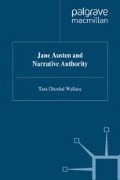Abstract
This book offers a reading of Jane Austen’s examination of her own narrative authority, and, by implication, of the authority of all narrators of fiction. I argue that each of Austen’s finished novels interrogates the claims of authoritative narrators and that the Austen canon as a whole articulates a range of anxieties and strategies having to do with authorship and authority. The six novels experiment in different ways with possible sources and ultimate failures of authority, always returning to the compromised figure of the fallible narrator. At the same time, Austen’s novels are far more than artefacts of self-reflexivity: they challenge and enable readers to move beyond a deconstructive dismantling of her texts toward an effective theory of narrative interpretation. As readers encounter Austen’s careful exploration of authorial anxiety, they engage in a complex negotiation between narrator and audience; pressed to recognize ways in which texts both claim and disavow authority, readers begin to develop interpretative strategies that can account for narrators’ manipulations as well as their anxieties.
Access this chapter
Tax calculation will be finalised at checkout
Purchases are for personal use only
Preview
Unable to display preview. Download preview PDF.
Notes
Juliet McMaster, ‘The Continuity of Jane Austen’s Novels’, Studies in English Literature 10 (1970) 724. McMaster continues: ‘Her novels belong to each other, each being in some way a development or a qualification of the last, a preparation for the next.’ Dividing what McMaster unites, Mary Lascelles points to the way Austen concurrently worked on different manuscripts, able to ‘project her imagination into one or another of these fragile bubble worlds, and let it dwell there’ (Jane Austen and Her Art [Oxford: Oxford University Press, 1939, rpt. 1974] 33). John Halperin, who finds the Juvenilia only ‘intermittently entertaining’, nevertheless notes that ‘[t]hey are chiefly interesting in illuminating for us Jane Austen’s first struggles to find a literary voice of her own’ (‘Unengaged Laughter: Jane Austen’s Juvenilia’, Jane Austen’s Beginnings: The Juvenilia and Lady Susan, ed. J. David Grey, Foreword by Margaret Drabble [Ann Arbor: UMI Research Press, 1989] 30).
Mary Poovey, The Proper Lady and the Woman Writer: Ideology as Style in the Novels of Mary Wollstonecraft, Mary Shelley, and Jane Austen (Chicago: University of Chicago Press, 1984) 178.
Deborah Kaplan, Jane Austen among Women (Baltimore: Johns Hopkins University Press, 1992) 163.
Leroy W. Smith, Jane Austen and the Drama of Women (New York: St. Martin’s Press, 1983) 52; Barbara Horwitz, ‘Lady Susan: The Wicked Mother in Jane Austen’s Work’, Jane Austen’s Beginnings 184; Mary Poovey 175.
Susan Sniader Lanser, Fictions of Authority: Women Writers and Narrative Voice (Ithaca: Cornell University Press, 1992) 68.
My contention that Austen’s works interrogate the omniscient stance disagrees with P.J.M. Scott’s statement that ‘By not assuming, however fugitively, anything less than absolute omniscience while speaking directly about her personages… this author becomes the most perspicuous of mediums’ (Jane Austen: A Reassessment [London: Vision Press, 1982] 172).
Richard F. Patteson, ‘Truth, Certitude, and Stability in Jane Austen’s Fiction’, Philological Quarterly 60 (Fall 1981) 465. His formulation seems excessively determinate in its insistence on ontological uncertainty and insufficiently calibrated to each of Austen’s separate, and, I believe, self-consciously different investigations of narrative positioning.
Author information
Authors and Affiliations
Copyright information
© 1995 Tara Ghoshal Wallace
About this chapter
Cite this chapter
Wallace, T.G. (1995). Introduction: Lady Susan’s Progeny. In: Jane Austen and Narrative Authority. Palgrave Macmillan, London. https://doi.org/10.1057/9780230372948_1
Download citation
DOI: https://doi.org/10.1057/9780230372948_1
Publisher Name: Palgrave Macmillan, London
Print ISBN: 978-1-349-39200-1
Online ISBN: 978-0-230-37294-8
eBook Packages: Palgrave Literature & Performing Arts CollectionLiterature, Cultural and Media Studies (R0)

